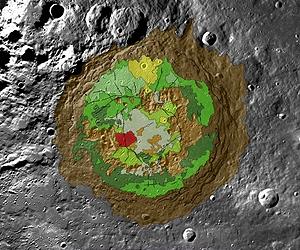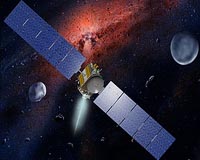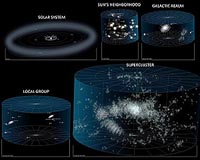|
 The Moon Puts On Camo
The Moon Puts On CamoGreenbelt MD (SPX) Aug 31, 2010 A new geologic map of the moon's Schrodinger basin paints an instant, camouflage-colored portrait of what a mash-up the moon's surface is after eons of violent events. The geologic record at Schrodinger is still relatively fresh because the basin is only about 3.8 billion years old; this makes it the moon's second-youngest large basin (it's roughly 320 kilometers, or 200 miles, in diameter). Schrodinger is located near the moon's south pole, a region where pockets of permanent ice are thought to e ... read more |
. |
|
|
Free Space, Earth, Energy And Military Newsletters - Delivered Daily |
| . | . |
| .. |
How The First Super-Massive Black Holes Were Born Columbus OH (SPX) Aug 26, 2010
Columbus OH (SPX) Aug 26, 2010Astronomers believe they have discovered the origin of our universe's first super-massive black holes, which formed some 13 billion years ago. The discovery fills in a missing chapter of our universe's early history, and could help write the next chapter - in which scientists better understand how gravity and dark matter formed the universe as we know it. In the journal Nature, Ohio State ... more Richest Planetary System Discovered  Paris, France (SPX) Aug 26, 2010
Paris, France (SPX) Aug 26, 2010Astronomers using ESO's world-leading HARPS instrument have discovered a planetary system containing at least five planets, orbiting the Sun-like star HD 10180. The researchers also have tantalising evidence that two other planets may be present, one of which would have the lowest mass ever found. This would make the system similar to our Solar System in terms of the number of planets (sev ... more Space detector prepares to scour universe for secrets  Geneva (AFP) Aug 25, 2010
Geneva (AFP) Aug 25, 2010A huge physics detector that will scour outer space for clues to the origins of the universe began the first stage of its voyage to the International Space Station at Geneva airport on Wednesday. The European Organisation for Nuclear Research (CERN) loaded the Alpha Magnetic Spectrometer (AMS) onto a giant C5 Galaxy US military transport plane, which will fly it to the Kennedy Space Centre i ... more |
.. |
 NASA prepares for asteroid rendezvous  Solar System May Be 2 Million Years Older Than We Thought  Instant online solar energy quotes Solar Energy Solutions from ABC Solar |
.. |
|
|
Free Space, Earth, Energy And Military Newsletters - Delivered Daily |
|
|
. |
 British bacteria are hardy space travelers
British bacteria are hardy space travelersLondon (UPI) Aug 23, 2010 Bacteria from cliffs on the south coast of England have proved themselves hardy astronauts, surviving a year and a half as space travelers, researchers say. Taken from the cliffs near the small fishing village of Beer in Devon, the bacteria were placed on the outside of the International Space Station to see how they would deal with harsh conditions in Earth orbit, the BBC reported. The bacteria were sent up still sitting on, and in, small chunks of cliff rock. They were placed in experi ... read more |
| The contents herein, unless otherwise known to be public domain, are Copyright 1995-2010 - SpaceDaily. AFP and UPI Wire Stories are copyright Agence France-Presse and United Press International. ESA Portal Reports are copyright European Space Agency. All NASA sourced material is public domain. Additional copyrights may apply in whole or part to other bona fide parties. Advertising does not imply endorsement, agreement or approval of any opinions, statements or information provided by SpaceDaily on any web page published or hosted by SpaceDaily. Privacy statement |
| Previous Issues | Aug 30 | Aug 27 | Aug 26 | Aug 25 | Aug 24 |